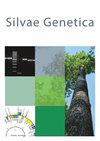Recent clonal reproduction of Cryptomeria japonica in a snowy region revealed by a survey of small-sized ramets
IF 1
4区 农林科学
Q3 FORESTRY
引用次数: 2
Abstract
Abstract Clonal reproduction may contribute to population maintenance in areas where disturbance caused by snow limits tree recruitment. To understand the importance of clonal reproduction in the population dynamics of canopy tree species, it is necessary to determine the frequency of clonal reproduction in the early stages of seedling establishment. We found 106 ramets, including “small-sized” ramets of less than 5 cm in diameter at breast height, aggregated within 4 patches in a 70 × 50 m plot and also identified 20 genets among these ramets with the use of nuclear microsatellite markers. The size structure of the ramets revealed an inverse J-shaped distribution, suggesting that continuous recruitment of new ramets occurs. However, the number of intermediate-sized ramets (around 10 cm DBH) at the present study site was small, suggesting that most new ramets die while they are still small by pressure from heavy snow. Of the 20 genets, 12 included one or more small-sized ramets, which indicated recent recruitment. Of the 12 genets, 3 included only a single small-sized ramet, which suggested seedling recruitment, whereas the other 9 included multiple ramets (39 small-sized ramets in total), which indicated clonal recruitment. The frequency (9/12) and number (39/9) of recent clonal recruits suggest that clonal reproduction effectively maintains the population of Cryptomeria japonica in snowy regions.小型分株调查揭示了雪区柳杉无性系繁殖的近代性
摘要在积雪干扰限制树木补充的地区,无性系繁殖可能有助于种群维持。为了了解无性系繁殖在冠层树种种群动态中的重要性,有必要确定树苗建立初期无性系繁殖的频率。在70 × 50 m的样地中,我们发现106个品种(包括胸高直径小于5 cm的“小型”品种)聚集在4个斑块内,并利用核微卫星标记在这些品种中鉴定了20个基因。分节的大小结构呈反j型分布,表明新分节不断增加。然而,在目前的研究地点,中型品种(约10厘米胸径)的数量很少,这表明大多数新品种在它们还很小的时候就因大雪的压力而死亡。在这20个基因中,有12个包含一个或多个小型株,这表明最近被招募。在12个基因中,有3个基因只包含一个小分株,表明存在苗期招募;另外9个基因包含多个分株(共39个小分株),表明存在无性系招募。近期无性繁殖的频率(9/12)和数量(39/9)表明无性繁殖有效地维持了雪区柳杉的种群数量。
本文章由计算机程序翻译,如有差异,请以英文原文为准。
求助全文
约1分钟内获得全文
求助全文
来源期刊

Silvae Genetica
农林科学-林学
CiteScore
2.20
自引率
10.00%
发文量
10
审稿时长
3 months
期刊介绍:
Silvae Genetica is an international peer reviewed journal with more than 65 year tradition and experience in all fields of theoretical and applied Forest Genetics and Tree breeding. It continues "Zeitschrift für Forstgenetik und Forstpflanzenzüchtung" (Journal of Forest Genetics and Forest Tree Breeding) founded by W. LANGNER in 1951.
 求助内容:
求助内容: 应助结果提醒方式:
应助结果提醒方式:


